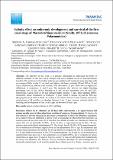| dc.creator | Vargas Ceballos, Manuel A. | |
| dc.creator | Vega Villasante, Fernando | |
| dc.creator | García Guerreo, Marcelo U. | |
| dc.creator | Chong Carrillo, Olimpia | |
| dc.creator | Badillo Zapata, Daniel | |
| dc.creator | López Uriarte, Ernesto | |
| dc.creator | Wehrtmann, Ingo S. | |
| dc.date.accessioned | 2020-09-16T20:47:30Z | |
| dc.date.available | 2020-09-16T20:47:30Z | |
| dc.date.issued | 2018 | |
| dc.identifier.citation | https://panamjas.org/artigos.php?id_publi=234 | |
| dc.identifier.issn | 1809-9009 | |
| dc.identifier.uri | https://hdl.handle.net/10669/81568 | |
| dc.description.abstract | The objective of this work is to provide information to understand the effect of different salinities on the survival of embryos and newly-hatched larvae of Macrobrachium tenellum. The survival of M. tenellum embryos was similar in all treatments up to nine days with an average of 94%. At day 12, survival was higher at the lower salinities (90 and 80% at 10 and 0 psu, respectively), whereas total mortality was observed at 30 psu. There were no significant differences in treatments 10 and 0 psu. The treatment that showed the higher hatching percentage was 10 psu (82%); hatching at 0 and 20 psu treatments were 60 and 55%, respectively. Larvae kept at 10 psu showed higher survival 7 days after hatching (98%), meanwhile, larvae maintained in freshwater (0 psu) failed to survive beyond the fifth day (keeping the larvae without food). According to the results obtained in this research, embryonic development of M. tenellun can develop between 0 and 10 psu, whereas, optimal salinity for hatching and development of first larval stages are between 10 and 9 psu. | es_ES |
| dc.description.abstract | El objetivo de este trabajo es proveer información que ayude a comprender el efecto de diferentes salinidades en la supervivencia de embriones y larvas recién eclosionadas de Macrobrachium tenellum. La supervivencia de los embriones de M tenellum fue similar en todos los tratamientos hasta los nueve días con un promedio de 94%. A los 12 días, la supervivencia fue de 0% a 30 ups, mientras que en los demás tratamientos (20, 10 y 0 ups) fue de 50, 90 y 80 % respectivamente. No se encontraron diferencias significativas en los tratamientos 10 y 0 ups. El tratamiento que mostró mayor porcentaje de eclosión fue 10 ups (82%) en comparación con los tratamientos de 0 y 20 ups donde eclosionaron el 60 y 55% respectivamente. En 10 ups las larvas mostraron la
supervivencia más alta a los 7 días posteriores a la eclosión (98%), por el contrario las larvas mantenidas en agua dulce (0 ups) no lograron sobrevivir más allá del quinto día (manteniendo las larvas sin alimento). De acuerdo con los resultados obtenidos en esta investigación, el desarrollo embrionario de M. tenellun puede desarrollarse entre 0 y 10 ups, mientras que la salinidad óptima para la eclosión y el desarrollo de las primeras etapas larvarias están entre 10 y 9 ups. | es_ES |
| dc.language.iso | en_US | es_ES |
| dc.source | Pan-American Journal of Aquatic Sciences, vol.13(4), pp.273-281 | es_ES |
| dc.subject | Prawn | es_ES |
| dc.subject | Embryo | es_ES |
| dc.subject | Larvae | es_ES |
| dc.subject | in vitro | es_ES |
| dc.subject | Langostino | es_ES |
| dc.subject | Embrión | es_ES |
| dc.subject | Larvas | es_ES |
| dc.subject | Eclosión | es_ES |
| dc.title | Salinity effect on embryonic development and survival of the first zoeal stage of Macrobrachium tenellum (Smith, 1871) (Crustacea, Palaemonidae) | es_ES |
| dc.title.alternative | Efecto de la salinidad en el desarrollo embrionario y la supervivencia del primer estadio zoea de Macrobrachium tenellum (Crustacea, Palaemonidae) | es_ES |
| dc.type | artículo original | |
| dc.description.procedence | UCR::Vicerrectoría de Investigación::Unidades de Investigación::Ciencias Básicas::Centro de Investigación en Ciencias del Mar y Limnología (CIMAR) | es_ES |
| dc.description.procedence | UCR::Vicerrectoría de Docencia::Ciencias Básicas::Facultad de Ciencias::Escuela de Biología | es_ES |


